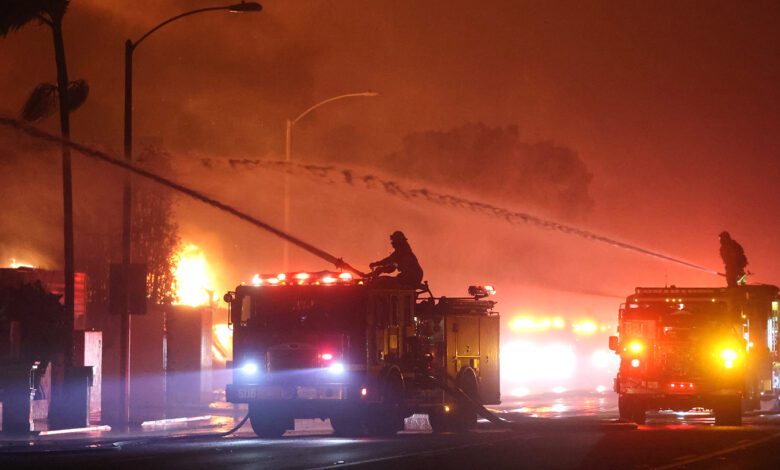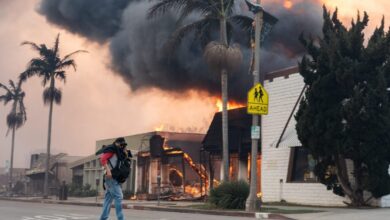Senior living communities ‘deeply impacted’ by Southern California wildfires but rising to challenge to protect residents, each other

With several more days of deadly destruction at the hands of Southern California wildfires anticipated to lie ahead, senior living providers already have been “deeply impacted,” one industry insider says. But they are rising to the challenge to protect their residents and help others.
“Extreme fire behavior” continues to challenge firefighters, according to CAL FIRE. At least 130,000 residents, some of them senior living residents, were under evacuation orders as of Thursday due to the wildfires spreading across Los Angeles County.
The Palisades Fire burned more than 17,000 acres, along with landmarks in Pacific Palisades and along the Pacific Coast Highway toward Malibu. The Eaton fire burned 10,600 acres, the Sunset Fire burned 60 acres and triggered evacuation orders in Hollywood and the Hollywood Hills, and the Hurst Fire had burned 855 acres as of Thursday afternoon, according to CAL FIRE.
Sister media brand McKnight’s Long-Term Care News shared NBC coverage in Altadena, CA, showing an ominous scene as thick smoke clouds blanketed the sky and nursing home residents pushed wheelchairs, walkers and oxygen tanks as they scrambled to safety amid smoldering embers.
Rising to the challenge
LeadingAge California President and CEO Jeannee Parker Martin said that many of the association’s members in Los Angeles County and surrounding areas have been “deeply impacted” by the wildfires, with several life plan communities and affordable housing communities evacuated, and others preparing to evacuate. The association, she added, has been in close contact with members and the state government to help move mutual aid resources across the region.
“To no surprise, our members have risen to the challenge,” Martin said. “Those in unaffected areas are providing independent, assisted, memory care and skilled nursing beds to displaced residents. Our business partners are providing meals and transportation to residents and staff in the evacuation centers.”
Several staff members also have lost their homes and been displaced.
“The size and scope of this event will leave an impact on our community for years to come. We are only beginning to understand the scope of the devastation,” Martin said. “The disaster underscores the need for a long-term care mutual aid system, which California lacks. We will continue our advocacy efforts with the legislature and administration to develop a system that ensures the safety of Californians living in care settings.”
LeadingAge California has an emergency management page on its website that includes the latest guidance from key agencies and departments, emergency alerts and preparedness resources. According to the site, the association is looking for food, furniture and other emergency supplies, as well as donations to its Disaster Relief Fund to help support evacuated communities.
“The provider community has a strong track record of being incredibly supportive of each other and working to assist all communities, residents and team members who are affected when disaster strikes,” California Assisted Living Association President and CEO Heather Harrison told McKnight’s Senior Living. “As the situation in Los Angeles continues to evolve, needs are being assessed by those in the area. Residents of impacted communities are being accepted by providers who are not impacted in nearby areas.”
On its website, Duarte, CA-based HumanGood said it had completed evacuations for its Royal Oaks life plan community and Rosewood Court affordable housing community due to the Eaton Fire. The company also was monitoring fire activity near two other affordable housing communities. Residents and staff members not staying with family members or friends were relocated to HumanGood’s other Southern California communities or hotels.
The California Department of Social Services’ Community Care Licensing Division, which licenses residential care facilities for the elderly and continuing care retirement communities, among other care settings, is maintaining and continually updating an evacuation list on its website.
Preparedness and planning
No injuries or deaths of senior living residents have been reported, and fire safety expert Stan Szpytek attributes it to providers establishing a state of readiness and a culture of preparedness. He is president of Fire and Life Safety Inc., a consulting firm and the life safety / disaster planning consultant for the California Association of Health Facilities and Arizona Health Care Association.
Senior living providers tend to be focused on quality of care and amenities, he said, cautioning, however, that emergency preparedness can’t be a backburner issue. Providers must be as flexible as first responders, Szpytek added.
“It’s a normal day until it isn’t,” he said. “That’s the mindset that providers need to have.”
That mindset begins with identifying internal and external hazards and perils through a hazard vulnerability assessment, Szpytek said. An organization’s HVA process involves assessing every potential type of disaster for the likelihood of frequency that it could occur, the effects it would have on an organization, and mitigation efforts already in place, he added.
That information, in turn, feeds into an “all hazards plan” that looks at all of the possible emergencies and informs protocols and written plans to provide guidance. The most important element of the plan, Szpytek said, is the emergency management framework that establishes an incident command system.
“You manage the chaos by having a framework of how to manage the incident, not letting the incident manage you,” he said, adding that once an incident management system is integrated into an emergency plan, frequent training and testing must occur. Szpytek recommends that communities address disaster preparedness with all staff members every quarter.
Importantly, he said, the planning process must include plans for recovery. Before returning evacuated residents to a community, Szpytek said, a list of things must be considered, including air and water quality systems, air quality, critical emergency systems and more.
Szpytek called the Camp Fire in Paradise, CA, in 2018 a “game changer” in fire preparedness due to the “extraordinary” fire behavior. That fire, which destroyed several senior living communities and other long-term buildings, initially was thought to be a once-in-a-lifetime event, but Szpytek said that such incidents are becoming the norm of fire behavior in western states due to environmental conditions such as drought.




